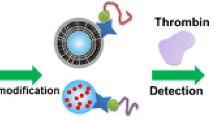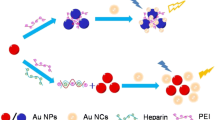Abstract
Heparins are widely used anticoagulant drugs. The current monitoring practice for heparin in plasma, such as the chromogenic anti-factor Xa assay, relies on heparin-triggered activation of antithrombin, an inhibitor of coagulation proteases. Such assays are not applicable to the detection of non-anticoagulant heparins, an emerging class of drug candidates for therapeutic applications unrelated to anticlotting activity. This study describes the application of a commercially available fluorescent probe assay (Heparin Red) for the direct and sensitive detection of the “chemical” heparin in plasma, independent of any anticoagulant activity. The quantification range is about 0–5 μg/mL for both unfractionated heparin (corresponding to 0–1 IU/mL) and the low molecular weight heparin enoxaparin. The Heparin Red assay is of particular value for the quantification of non-anticoagulant heparins, as exemplified by the low molecular weight heparin derivative tafoxiparin and a N-desulfated-N-reacetylated heparin. Heparin octa- and decasaccharides are also detected.

Heparin quantification in plasma by mixing the sample with the Heparin Red reagent and fluorescence readout












Similar content being viewed by others
References
Baglin T, Barrowcliffe TW, Cohen A, Greaves M. Guidelines on the use and monitoring of heparin. Br J Haematol. 2006;133:19–34.
Harenberg J. Is laboratory monitoring of low molecular weight heparin therapy necessary? Yes. J Thromb Haemsot. 2004;2:547–50.
Gray E, Mulloy B, Barrowcliffe TW. Heparin and low-molecular-weight heparin. Thromb Haemost. 2008;99:807.
Casu B, Harenberg J, Non-anticoagulant actions of glycosaminoglycans. Springer 1996.
Page C. Heparin and related drugs: beyond anticoagulant activity. ISRN Pharmacology. 2013;2013: ID 910743.
Cassinelli G, Naggi A. Old and new applications of non-anticoagulant heparin. Int J Cardiol. 2016;212:S14–21.
Ekman-Ordeberg G, Hellgren M, Akerud A, Andersson E, Dubicke A, Sennstrom M, et al. Low molecular weight heparin stimulates myometrial contractility and cervical remodeling in vitro. Acta Obstet Gynecol Scand. 2009;88:984–9.
Leitgeb AM, Blomqvist K, Cho-Ngwa F, Samje M, Nde P, Titanji V, et al. Low anticoagulant heparin disrupts Plasmodium falciparum rosettes in fresh clinical isolates. Am J Trop Med Hyg. 2011;84(3):390–6.
Ritchie JP, Ramani VC, Ren Y, Naggi A, Torri G, Casu B, et al. SST0001 a chemically modified heparin inhibits myeloma growth and angiogenesis via disruption of the heparanase/syndecan-1 axis. Clin Cancer Res. 2011;17:382–1393.
Zhou H, Roy S, Cochran E, Zouaoui R, Chu CL, Duffner J, et al. M402 a novel heparan sulfate mimetic targets multiple pathways implicated in tumor progression and metastasis. PLoS ONE. 2011;6, e21106.
Szelke H, Schuebel S, Harenberg J, Kraemer R. A fluorescent probe for the quantification of heparin in clinical samples with minimal matrix interference. Chem Commun. 2010;46:1667–9.
Wright AT, Zhong ZL, Anslyn EV. A functional assay for heparin in serum using a designed synthetic receptor. Angew Chem Int Ed. 2005;44:5679.
Bromfield SM, Wilde E, Smith DK. Heparin sensing and binding—taking supramolecular chemistry towards clinical applications. Chem Soc Rev. 2013;42:9184–95. and references cited therein.
Szelke H, Harenberg J, Schübel S, Krämer R. Interaction of heparin with cationic molecular probes: probe charge is a major determinant of binding stoichiometry and affinity. Bioorg Med Chem Lett. 2010;20:1445–7.
Coamatic® Heparin. Chromogenix Instrumentation Laboratory SpA. http://www.heparinmonitoring.com/downloads/Insert%20-%20Coamatic%20Heparin.pdf . Accessed 19 Jun 2016.
Mulloy B, Forster MJ, Jones C, Davies BD. Biochem J. 1993;293:849–58.
Bisio A, Vecchietti D, Citterio L, Guerrini M, Raman M, Bertini S, et al. Structural features of low-molecular-weight heparins affecting their affinity to antithrombin. Thromb Haemost. 2009;102:865–73.
Heparin oligosaccharides. Iduron Ltd. http://www.iduron.co.uk/products/glycosaminoglycan-oligosaccharides/heparin-oligosaccharides/. Accessed 19 Jun 2016
Stewart K, Hughes E, Yates EA, Huang T-Y, Lima MA, Rudd TR, et al. Atomic details of the interactions of glycosaminoglycans with amyloid beta fibrils. J Am Chem Soc. 2016. doi:10.1021/jacs.6b02816.
Gerotziafas TS, Petropoulou AD, Verdy E, Samama MM, Elalamy I. Effect of the anti-factor Xa and anti-factor IIa activities of low-molecular-weight heparins upon the phases of thrombin generation. J Thromb Haemost. 2007;5:955–62.
Sanfelippo MJ, Tillema VB. Automated assay for fondaparinux (Arixtra) on the Dade Behring BCS XP. Am J Clin Pathol. 2009;132:608–12.
van Putten J, van de Ruit M, Beunis M, Hemker HC. Interindividual variation in relationships between plasma heparin concentration the results of five heparin assays. Clin Chim Acta. 1982;12:261–70.
Galli M, Magen H, Einsele H, Chatterjee M, Grasso M, Specchia G, et al. Roneparstat (SST0001), an innovative heparanase (HPSE) inhibitor for multiple myeloma (MM) therapy: first in man study. Blood. 2015;126:3246.
Lehman CM, Rettmann JA, Wilson LW, Markewitz BA. Comparative performance of three anti-factor Xa heparin assays in patients in a medical intensive care unit receiving intravenous, unfractionated heparin. Am J Clin Pathol. 2006;126:416–21.
Author information
Authors and Affiliations
Corresponding author
Ethics declarations
Conflict of interest
R. Krämer holds shares in Redprobes UG, Münster, Germany. The other authors have no conflict of interest.
Rights and permissions
About this article
Cite this article
Warttinger, U., Giese, C., Harenberg, J. et al. A fluorescent probe assay (Heparin Red) for direct detection of heparins in human plasma. Anal Bioanal Chem 408, 8241–8251 (2016). https://doi.org/10.1007/s00216-016-9940-y
Received:
Revised:
Accepted:
Published:
Issue Date:
DOI: https://doi.org/10.1007/s00216-016-9940-y




